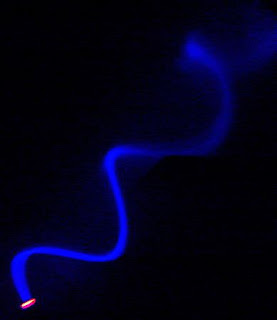Above example of wire between 2 magnets could be used to make simpler direct current (DC) generator or DC motor. It should be easy enough to teach 10 year old kids in poorest countries how to build simple motors within hour. Batteries are source of DC.
Like seen on above image wires are close but not touching.
Alternating current (AC) using motors and generators can be similar but with extra complexity designed to rotate parts of it right amount before current changes direction so inertia would not be lost.
Reason how same design can work as generator and engine is that charged particles behave according to right hand rule. According to that if charged particle moves perpendicular to magnetic field lines (B) between south and north pole then magnetic field forces charged particles to move circularly in direction that is at 90 angle with present direction of current.
For example electron beam above keeps rotating in magnetic field with consistent radius. This effect is also used in particle accelerator sensors to see what charges did the new seen particles have as they know direction of magnetic field and which charge should rotate which way.
If charged particle moves perpendicular to magnetic field lines then they will always spiral or move circularly. Positive charge would be forced to move in direction F on above image and electron would turn to opposite side but if charge doesn't move in relation to magnet then they have no effect on each other.
These 3 directions B, v and F are at 90 degree angle with other 2 directions.

These 3 directions have been described with Fleming's left hand and right hand rule although they show same basic thing in different situations. Left hand example is used to describe generators and right hand example to illustrate engines. In left hand example if current flows in direction shown compared to magnetic field direction then entire wire would be pulled somewhat sideways (thrust of motion). In motor charges moved because electricity flowed but in generator this movement can be cause by moving wire or any electric conductor through magnetic field and charged particles would start to move but in generators wire is oriented so force makes charged particles move in wire not push wire sideways because charges couldn't exit wire through insulation. For example if wire is held parallel to direction F in third hand rule illustration and moved horizontally up towards v then magnetic field forces current to move in direction F. In motor if wire is vertical with direction v then letting current flow in that direction would force entire wire towards direction F if positive charge moved there but wire would be forced to opposite direction if electron moved towards direction v.
In above image arrows show direction of electron movements. Using bent wire that goes both ways allows different parts of wires to be forced in opposite directions keeping entire wire moving circularly.
Tips of wires are connected to different pieces of split rings. Carbon brushes transmit electricity to split ring and wire that connects its sides but because the gap of split-ring may lose connection with brushes every 180 degree turn so voltage can go near zero twice per turn.
In AC generator and motor these rings get used bit differently. Here different tips of bent wires get connected to different rings which change polarity regularly so generator or motor could keep turning the same way. Such motors should have stable AC frequency dependent rotating speeds while DC motors may be able to rotate with almost any speed that their strength and air resistance would allow.
Alternator is generator for alternating current. It doesn't matter much if magnets do the moving or wires as long conductors change location in magnetic field. Alternator causes electricity by using same physics phenomena but due to magnetic field reversing during this movement the current it produces is also reversed about as often as it takes for a 180 degree turn for magnet. As main bonus AC can be transported up to hundreds of kilometers with little loss in power and AC is required for radio waves with radio waves having same frequency as AC that flowed in antenna. High frequency radio waves needed to transmit TV channels and radio can't use a magnet rotating over 100 million times per second but electronically such AC frequencies can me made without moving parts using logic gates and central clock.







